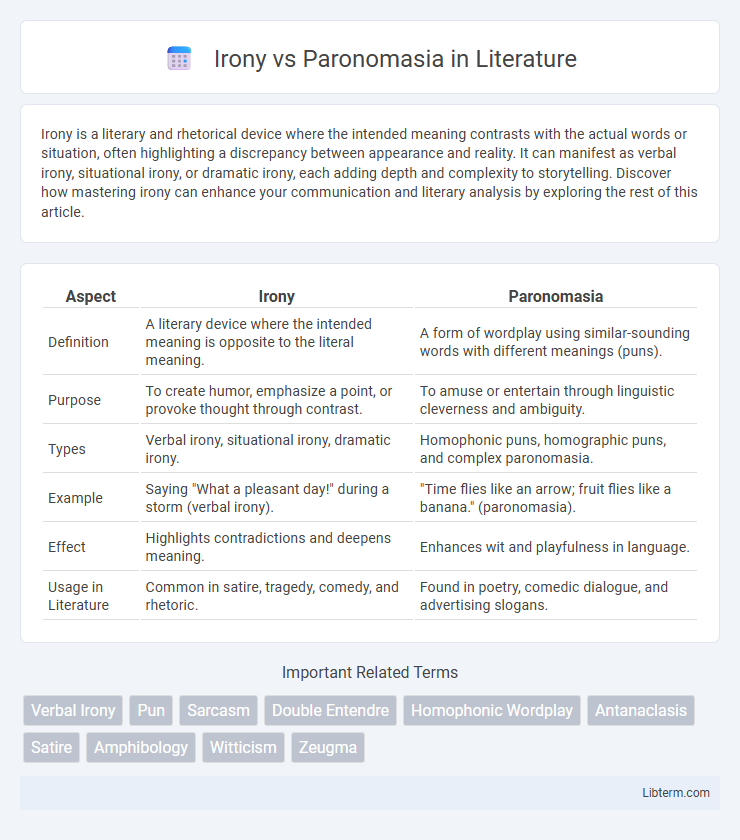Irony is a literary and rhetorical device where the intended meaning contrasts with the actual words or situation, often highlighting a discrepancy between appearance and reality. It can manifest as verbal irony, situational irony, or dramatic irony, each adding depth and complexity to storytelling. Discover how mastering irony can enhance your communication and literary analysis by exploring the rest of this article.
Table of Comparison
| Aspect | Irony | Paronomasia |
|---|---|---|
| Definition | A literary device where the intended meaning is opposite to the literal meaning. | A form of wordplay using similar-sounding words with different meanings (puns). |
| Purpose | To create humor, emphasize a point, or provoke thought through contrast. | To amuse or entertain through linguistic cleverness and ambiguity. |
| Types | Verbal irony, situational irony, dramatic irony. | Homophonic puns, homographic puns, and complex paronomasia. |
| Example | Saying "What a pleasant day!" during a storm (verbal irony). | "Time flies like an arrow; fruit flies like a banana." (paronomasia). |
| Effect | Highlights contradictions and deepens meaning. | Enhances wit and playfulness in language. |
| Usage in Literature | Common in satire, tragedy, comedy, and rhetoric. | Found in poetry, comedic dialogue, and advertising slogans. |
Understanding Irony: Definition and Types
Irony is a literary device where the intended meaning differs from the literal expression, often used to create humor or emphasize a point. Types of irony include verbal irony, where the speaker says the opposite of what they mean; situational irony, involving a discrepancy between expected and actual outcomes; and dramatic irony, where the audience knows something the characters do not. Understanding these forms enhances comprehension of nuanced communication in literature and everyday language.
What is Paronomasia? An Overview
Paronomasia, commonly known as a pun, is a rhetorical device that exploits the similarity of sounds between words with different meanings to create humor or a double entendre. It involves the deliberate use of homophones, homonyms, or words with multiple meanings to produce a witty or clever effect. Unlike irony, which relies on contrast between expectation and reality, paronomasia centers on phonetic wordplay to engage the audience.
Key Differences Between Irony and Paronomasia
Irony involves expressing meaning through words that signify the opposite, often highlighting contrast between expectation and reality; paronomasia, or punning, exploits similar-sounding words for humorous or rhetorical effect. Irony relies on situational or verbal discrepancy to create deeper insight or critique, while paronomasia depends on phonetic similarity and wordplay for entertainment or emphasis. Key differences include irony's focus on meaning reversal versus paronomasia's emphasis on linguistic ambiguity and sound-based humor.
Historical Origins of Irony and Paronomasia
Irony originated in ancient Greek literature, notably in the works of Socratic dialogues where it was used as a rhetorical device to express meaning opposite to the literal words. Paronomasia, or punning, dates back to classical Latin poetry and rhetoric, where wordplay emphasized phonetic similarities for humorous or poetic effect. Both devices have evolved through centuries of literary tradition, reflecting cultural nuances in language usage.
Irony in Literature: Classic and Modern Examples
Irony in literature serves as a powerful device to convey meaning opposite to the literal text, enriching narrative complexity and reader engagement. Classic examples include Jonathan Swift's "A Modest Proposal," which employs satirical irony to critique social issues, while modern uses appear in the works of authors like Kurt Vonnegut, who blends situational and verbal irony to underscore absurdity and human folly. Unlike paronomasia, which focuses on wordplay through similar sounds, irony emphasizes deeper contrasts between appearance and reality to provoke thought and highlight contradictions.
Paronomasia in Rhetoric: Wordplay Explained
Paronomasia, a rhetorical device rooted in wordplay, exploits similar-sounding words to create double meanings or humorous effects, often enhancing persuasive speech or literature. It differs from irony, which relies on contradictions between literal and intended meanings to evoke wit or criticism. Skilled use of paronomasia enriches language by engaging audiences with clever ties between phonetics and semantics, making arguments more memorable and impactful.
Effects of Irony vs Paronomasia on Readers
Irony evokes a sense of surprise or critical reflection by highlighting contradictions between expectations and reality, often provoking deeper thought or humor in readers. Paronomasia, or wordplay, delights readers through clever linguistic twists that enhance memorability and engagement while emphasizing nuances of meaning. Both devices enrich text by stimulating cognitive and emotional responses, but irony tends to challenge perceptions, whereas paronomasia emphasizes linguistic creativity.
Common Misconceptions About Irony and Paronomasia
Irony is often confused with sarcasm, but it involves a contrast between expectation and reality without necessarily intending mockery, while paronomasia relies on wordplay using similar sounds for humorous or rhetorical effect. A common misconception is that irony always involves verbal wit, whereas it can also be situational or dramatic, creating meaning through context rather than just words. Paronomasia is frequently mistaken for simple puns, though it specifically exploits phonetic similarities to enhance meaning beyond mere humor.
How to Use Irony and Paronomasia Effectively
Irony is used effectively by creating a contrast between expectations and reality, often highlighting contradictions or emphasizing humor through situational or verbal contexts. Paronomasia, or wordplay involving similar sounds or double meanings, engages audiences by adding cleverness and wit, making language more memorable and entertaining. To maximize impact, combine irony's subtlety with paronomasia's playful ambiguity, ensuring clarity so the intended message resonates without causing confusion.
Irony vs Paronomasia: Which is More Impactful?
Irony employs contrast between expectation and reality to deliver powerful, often thought-provoking messages that resonate deeply with audiences, while paronomasia relies on wordplay and phonetic similarities to create humor or wit. Irony's capacity to evoke strong emotional responses and provoke critical thinking often makes it more impactful in literature and rhetoric. Paronomasia, though entertaining, typically serves a lighter, more playful function that may not evoke the same level of depth or reflection as irony.
Irony Infographic

 libterm.com
libterm.com